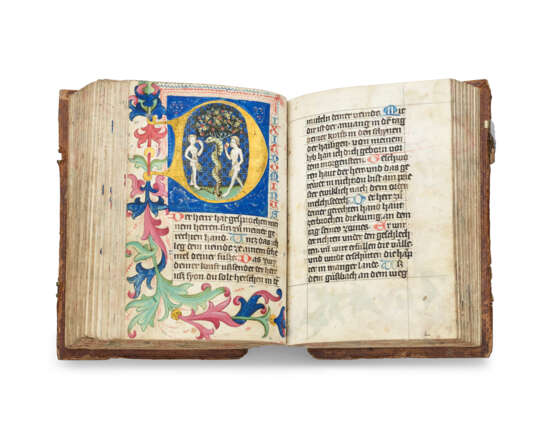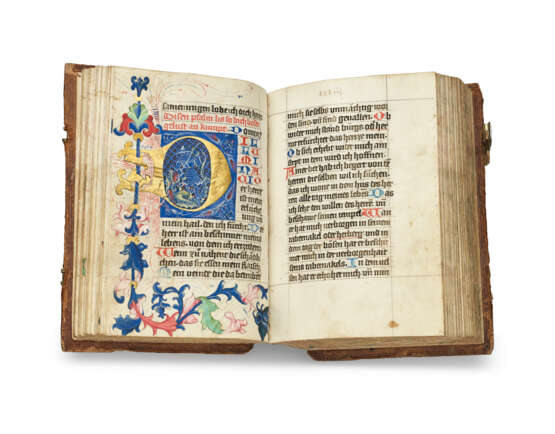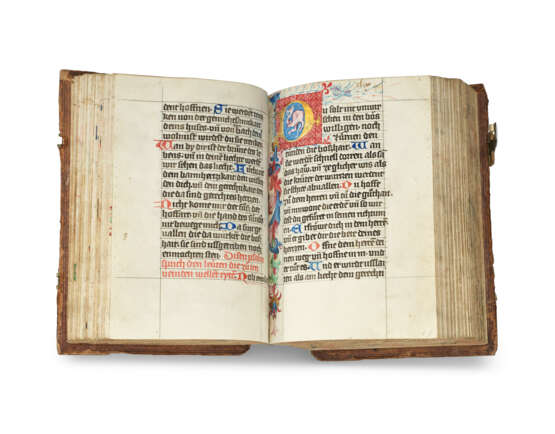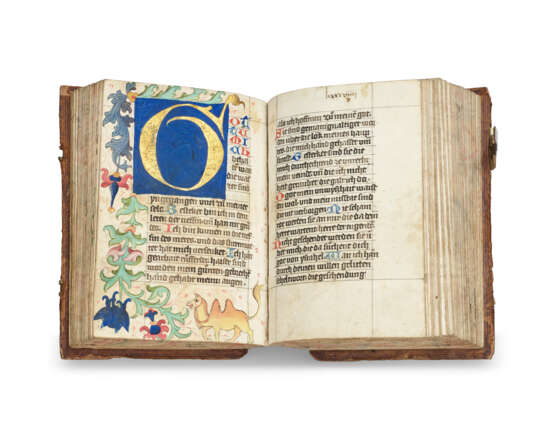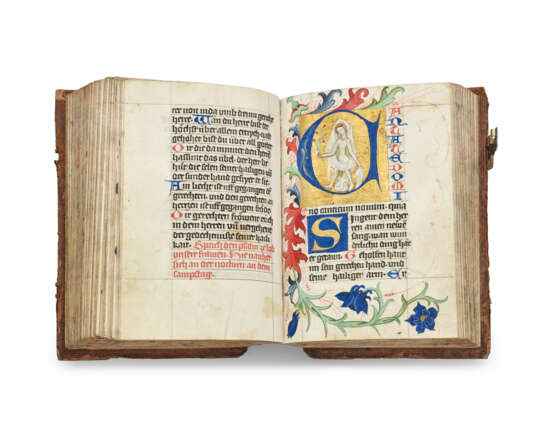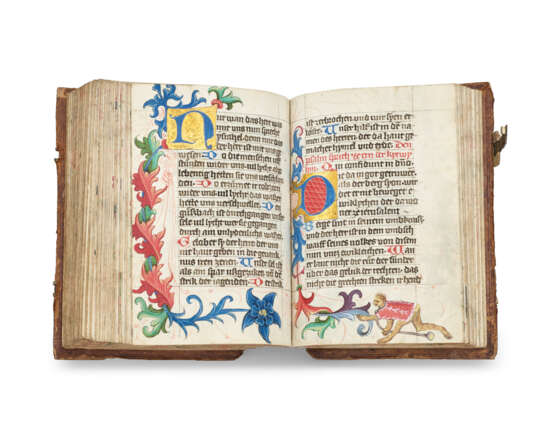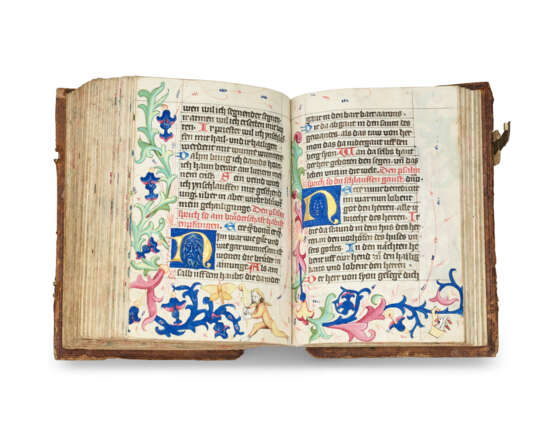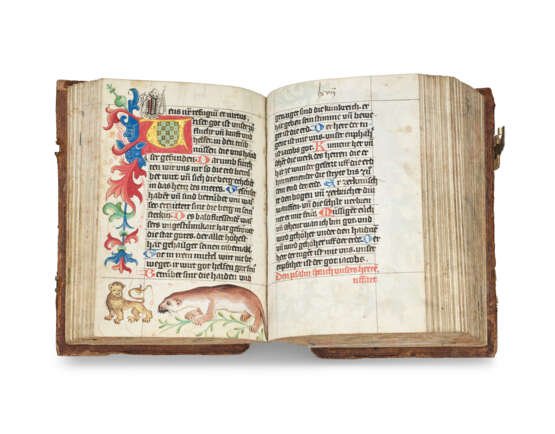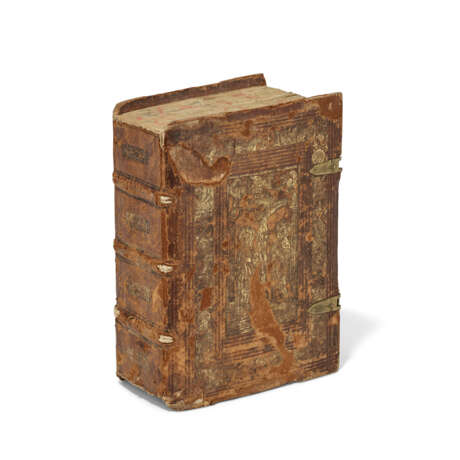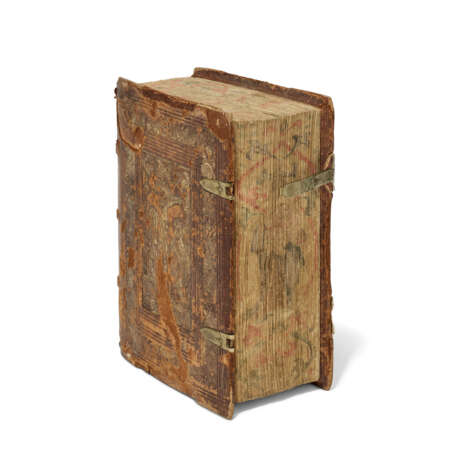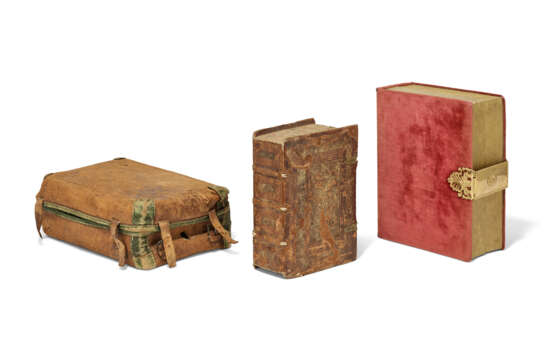ID 1349694
Лот 7 | The Psalter of Count Ludwig the Younger of Oettingen
Оценочная стоимость
£ 40 000 – 60 000
Psalter, in German with Latin incipits, illuminated manuscript on vellum, Swabia, 1418
Courtly art of the early 15th century: an entrancing and unpublished addition to the corpus of southern German illuminated manuscripts.
175 x 127mm, iii paper + 252 leaves, collation: 17(of 8 lacking i ?frontispiece or cancelled blank), 2-318, 325(of 6, vi pastedown), catchwords, some signatures, early incomplete foliation 1-19, xx-cxxxiiii, 18 lines, ruled space: 120 x 73mm, some prickings, one-line initials alternately in red or blue some with penwork including faces, eighteen mostly three-line initials in varying combinations of gold, blue, red and green flourished to form partial borders, over 135 mostly four- to five-line initials with partial borders largely of acanthus often with birds, beasts, insects and grotesques, nine large initials, six historiated, with similar borders (lacking the first leaf, slight trimming into some borders, in a few initials the lighter tones of the blue camaïeu decoration have darkened rendering the design illegible).
Early 17th-century binding of brown calf leather over wooden boards, gilt stamped with panels of the Crucifixion on the upper cover and of Christ Harrowing Hell on the lower cover within a border framed by fillets to either side with three half-length saints on each vertical band, metal clasps on leather hingers with metal catches, fore-edges painted with red and blue acanthus enclosing a standing Virgin with Child (lacking one clasp, somewhat worn). 19th-century book-shaped box opening at upper ‘joint’ with gilded ‘fore-edges’, pink velvet ‘binding’ and metal catch and clasp, (paper lining split at upper ‘joint’). 19th-century tan leather carrying case edged and reinforced in green leather, fastened with six straps with buckles (lacking three straps and buckles, one buckle stitched directly to case).
Provenance:
(1) Written by the Cistercian Oswald Braytenveld of Steinheim at Alerheim for Count (Graf) Ludwig the Younger of Oettingen (c.1380-1422) in sixteen weeks ending 14 September 1418: Do man salt vo[n] crists gebürt. tusend. vierhundert un[d] in dem achzehnd[en] iar. an des heiligen creütztag am herbst ward uffgeschriben der psalter. den schraib Oswald braytenveld von stainhen. ain munch grawes ordens…Geschriben uff Alerhen. Grauf Ludwigen dem iungern herren in xvj wuchen, colophon ff.251v-252.
Braytenveld may have come from the Steinheim now absorbed into Markt Wallerstein, by the Oettingen family’s most important castle, north of Nördlingen. Alerheim, to the east of Nördlingen, was where Count Ludwig the Younger was based, as stated by an Augsburg chronicler who describes him as zu Alerhaim gesessen when recording his death at the siege of Graisbach 1422, fighting with the League of Constance for the Duke of Bavaria-Landshut against the Dukes of Bavaria-Ingolstadt (P. Joachimsohn, ‘Zur städtischen und klösterlichen Geschichtschreibing Augsburgs in fünfzehnten Jahrhundert’, Alemannia, XXII. Bd (1894), pp.123-159, 146). It appears from the colophon that Braytenveld had been falsely accused of leaving the obedience of the Cistercian Abbey of Maulbronn (Württemberg), for ‘another Order’; this he emphatically rejects: living or dead, he will be a Cistercian. The nearest Cistercian Abbey to Alerheim was Kaisheim, founded 1133, about 15 km to the south east; Braytenveld could have been attached to the convent of Cistercian nuns of Klosterzimmern at Deiningen, founded in 1245, which was much closer to Alerheim and under the patronage of the Counts of Oettingen from the 14th century.
The numbering of the Oettingen Counts, among the greatest Swabian secular landholders, is not universally agreed, with co-rulers sometimes omitted: Ludwig the Younger’s father, Ludwig the Bearded (r.1371-1440) is numbered between IX and XII, the Younger, if numbered, usually appears as XII or XIII. Ludwig the Bearded married Beatrix von Helfenstein-Blaubeuren in 1374 and Ludwig the Younger was born before 1388. Ludwig the Bearded ruled jointly with his brother Friedrich (r.1378-1423); Ludwig the Younger and his brother Wilhelm were associated with them from about 1400. Since all Ludwig the Bearded’s sons predeceased him without heirs, in 1440 the Oettingen lands passed to the sons of Friedrich. The family survives today in the lines of Oettingen-Spielberg, raised to a principality in 1734, and Oettingen-Wallerstein, raised to a principality in 1774.
(2) Johannes Hofstetter, parish priest of Kötzting, in eastern Bavaria, gave the book to Sister Kunigunde Hehenriederin 8 May 1595: inscription, f.652.
(3) Ludwig Kraft Ernst Karl, Fürst zu Oettingen-Oettingen und Oettingen-Wallerstein (1791-1870): Fürst Louis Wallerstein, written in pencil on verso of first flyleaf, a form of his name which was current in his lifetime. A 19th-century hand has summarised the colophon on the verso of the second flyleaf, where a different hand has totalled the initials at 158 and the ‘miniatures’ at 5.
Prince Ludwig succeeded in 1802 to the principality of Oettingen-Wallerstein, absorbed into the Kingdom of Bavaria in 1806, and played a significant part in Bavarian affairs. He followed his father Prince Kraft Ernst (1748-1802) in purchasing medieval manuscripts and early printed books but, unlike his father, retained their bindings as part of his enthusiasm for medieval (pre-17th-century) art, which he avidly collected. In 1816 he moved his medieval collections to Wallerstein to be available as a museum, a project doomed by his precarious finances. He lost his position as head of the Oettingen-Wallerstein house in 1823 when he married morganatically; in 1862 he fled his creditors to Switzerland. His paintings had already been dispersed, going principally to Ludwig of Bavaria (now in the Alte Pinakothek, Munich) and to Albert, Prince Consort of Queen Victoria (now the British Royal Collection and the National Gallery, London). The Oettingen-Wallerstein library largely survived intact until a series of sales in the 1930s; the remainder has, since 1980, formed the Oettingen-Wallersteinsche Bibliothek of Augsburg University.
The Psalter, made for an earlier Ludwig von Oettingen, seems to have been acquired by Prince Ludwig not as an addition to the library but as a highly treasured personal possession. Its special case is most unlikely to predate his ownership; the practical leather carrying bag suggests that this exceptional manuscript travelled with him. It has passed by descent to the present owner.
Contents: Psalter in German with Latin incipits: the Psalms, ff.1-230, opening Disen psalm salt du lesen unserrn herren das er dich an allen gute[n] dingen bestätige. Beatus vir […] Selig ist der man der nit abgegangen is zu dem rat der unmilten [...] noch an der weg der sunder nit gestanden ist […] f.1, and ending Lobent in mit wolhellenden schellen. lobet in mit schellen des iubel gesanges. am ieglicher gaist lobt den herren f.230; the Canticles, das gesang der propheten, ff.230v-248, opening Confitebor tibi domine […] Ich vergich dir herre wan du bist mir erzürnet gewesen […] f.230v, and ending with the Te deum laudamus, introduced with Das lobsang hant gemacht Ambrosius un[d] Augustinus ye ainer ainen vers un[d] der ander den andern […] Dich gote loben wir: dich herren vergehen wir […], f.246, […] In dich herre han ich gehohffnet nicht werd ich geschendet ewikleichen f.248; the Athanasian Creed ff.248-251v, opening So ist das cristanlicher gelaub als in beschriben hant Athanasi[us] in concilio nycenensi. Quicumque vult […] Wer wil behalten syn vor allen dingen ist notdürftig dass er halt cristanlichen gelauben […] f.248, […] Ditz ist cristanlicher gelaub es sy den das in ain yeglicher getrewlich un[d] vesterkleich gelaube so mag er nit behalten syn, f.251v.
German translations of the Psalms, predominantly from the Gallican text of the Vulgate Bible, had been in circulation for centuries by 1418, evidence of a desire to understand fully a core element of Christian worship and devotional practice. Their popularity resulted in a complex textual tradition. From very limited sampling, Count Ludwig’s Psalter corresponds in some respects with a Psalter, perhaps from the Augsburg area, dated 1390 (Munich BSB cgm. 440), and in other respects with a Swabian Psalter of c.1457 (Stuttgart, Landesbibliothek cod. bibl. 4o 13). These have been classed in different subgroups of the Psalters related to the 14th-century manuscript in the library of the Cistercian Abbey of Vyšší Brod (German: Hohenfurt), cod. 27; this Group 9 is localised to the south-east of the German speaking area, see K.E. Schöndorf, Die Tradition der deutschen Psalmenübersetzung. Untersuchungen zur Verwandtschaft und Übersetzungstradition der Psalmenverdeutschung zwischen Notker und Luther, 1967, pp.283-84, 249; for texts from these mss, see W. Walther, Die deutsche Bibelübersetzung des Mittelalters, Bd II, 1892, nos 11 and 16, col. 620, 624, 571, 573, 577.
It is impossible to know whether a calendar preceded the lost first leaf. Against its presence is the absence of other frequent adjuncts of a Psalter that were certainly never included: the placing of the colophon shows that neither the Apostles’ Creed nor litany followed the Athanasian Creed. The large initials mark the usual eight part division that allowed the whole Psalter to be recited in the course of a week, from Sunday to Saturday, with the eighth section for Sunday vespers. Unusually the Psalm for Saturday vespers, Ps. 143, is also distinguished, f.222v, and its place in the weekly cycle explained in the heading. Mostly, however, the headings are directed at personal devotions: the first psalm for Tuesday, Ps. 38, for instance, is preceded by the instruction that you should read it when taking the Eucharist and also to your guardian angel, f.54v.
Illumination:
Bohemian illuminators, creators towards 1400 of some of Europe’s most beautiful manuscripts, had an influence that extended beyond the court of Wenceslas IV (1361-1419), most immediately into neighbouring Austria and Southern Germany. Count Ludwig’s Psalter delightfully demonstrates that influence with its fine historiated initials, variety of gilded backgrounds and acanthus borders inhabited by an intriguing range of creatures. Although the naked lady at Psalm 97, f.150, is reminiscent of Wenceslas IV’s emblematic scantily clad bath maidens, as in his Bible of c.1390-1400 (Vienna. ÖNB, cod. 2759–2764), other features seem developed from slightly later Bohemian conventions. The range and scale of the figures in the borders and the exuberant acanthus leaves relate more to the Office of St Jerome dated 1404 (Prague, Knihovna Národní muzeum, ms XII A 18) and the Bible of Konrad of Vechta of 1402-3 (Antwerp, Museum Plantin-Moretus, mss M 15.1 and M 15.2), where dragons and grotesques morph into foliate forms as in the Psalter, e.g. ff.22, 58, 204v.
Elsewhere, Count Ludwig’s devotions were to be accompanied by more dragons ff.12, 13r and v, 69, 77v, 213v, 234; monkeys, gazing in mirrors (aping human self-examination) ff.64v, 102, chained with a neck weight f.204, playing the lute f.214v; insects ff.11v, 87v, with a dragonfly f.34v, stag beetle f.206, butterfly pursued by a wildman f.209v; birds, including three in a basket f.210, green parakeets ff.24, 73, 139v, 245v and one lowering a basket f.89v, a crane f.77v; chaffinches ff.201v. 202; animals, like the diminutive lion threatened by a stoat f.66v, a camel f.98v, a bear f.204v; creatures of fantasy e.g. ff.86v, 209, a green pelican in its piety f.202v. A particularly beguiling feature is seen at most of the psalms opening ich (I) where the initial is formed by a golden fish, e.g. ff.8v, 17v, 36v, 177v, 180, 214v.
Some of the recurring border motifs, like the dragons or the columbines, may have been the Count’s personal emblems. At the time, the green parakeets would have been understood as a symbol of the League of Constance, which had been preceded by the Parakeet Society (Sittichgesellschaft), founded in 1414 by the Duke of Bavaria-Landshut as an alliance directed against Duke Ludwig VII of Bavaria-Ingolstadt. The parakeet was a mocking riposte to Ludwig VII’s badge, the black raven of St Oswald (see B. Glasauer, Herzog Heinrich XVI. (1393-1450) der Reiche von Bayern Landshut, 2009, pp.127-9).
The imagery of the large initials does not follow a coherent programme. The dragons of Ps.1, f.1, are followed by non-figurative patterning for Ps.38, f.54v. Ps.26’s metaphorical warring armies perhaps make appropriate the presence of St George vanquishing the dragon, f.32v; the warrior knight may well appear because he was a saint for whom the Count had a special devotion. Delicate touches of green and red here enhance the exquisite blue monochrome or camaïeu technique, seen also in some smaller initials and three further large initials: an angel for Ps.52, f.76; a design lost through darkening for Ps. 68, f.94v; curling foliage for Ps.80, f.125; an exotic warrior with raised sword for Ps.143, conceivably inspired by the verse where David is saved from a hostile sword, f.222v. Full colours are used for the nude with her branch of flowers at Ps.97, f.150. She seems captivatingly joyful yet is unlikely to relate directly to the joy commanded in the psalm; nothing identifies her as the bathing Bathsheba, who caused David to sin, and Ps.97 is not one of his Penitential Psalms. It is not even clear that the figure was understood as sinful, when naked ladies could hold Wenceslas IV’s emblems in his Bible. Sin is certainly the following subject: Adam and Eve stand either side of the serpent coiled round a delectable apple tree at Ps.109, f.176v, despite this psalm’s usual Trinitarian interpretation, which is mentioned in the heading.
The rich and sometimes surprising imagery could have been the work of Bohemians who had travelled into Germany but the bolder, strongly coloured forms of the Psalter are more likely to be German work, perhaps by two illuminators. The first, who opens the book, deploys sinewy, more sparsely leaved acanthus, closer to Bohemian models, and is generally more refined than the second, whose work is concentrated towards the end of the volume. They follow the same patterns and layouts so that precise attributions to separate hands are difficult: they may have collaborated on the same page or the changes could even represent the evolution of one artist. The illuminator/s could have worked in the ambit of the Young Count at Alerheim or in one of the great urban centres of illumination like Nuremberg or Augsburg. The presence of the parakeets throughout the Psalter suggests that it was completed before they acquired a tragic significance in 1422. It is ironic that the conflict that would cause the owner’s death is embodied in these jaunty birds, so cheerfully enlivening the margins.
The historiated initials feature: dragons f.1, St George and the dragon f.32v, angel playing lute f.76, naked lady with branch of flowers f.150, Adam and Eve f.176, exotic warrior f.222v.
Literature
For illumination in Southern Germany, exh. cat. J. Hamburger, et al. Bilderwelten Buchmalerei zwischen Mittelalter und Neuzeit, Munich, Bayerischen Staatsbibliothek, 2016, online at https://www.bsb-muenchen.de/fileadmin/pdf/publikationen/ausstellungskataloge/bilderwelten_ausstellungskatalog.pdf
J. Hamburger, R. Suckale, and G. Suckale-Redlefsen, eds, Painting the Page in the Age of Print: Central European Manuscript Illumination of the Fifteenth Century, 2018, trans. from Unter Druck: Mitteleuropäische Buchmalerei im Zeitalter Gutenbergs, 2015.
For Bohemian illumination, exh. cat. B. Drake Boehm and J. Fajt eds, Prague : the Crown of Bohemia, 1347-1437, New York, Metropolitan Museum, 2005, online at https://www.metmuseum.org/art/libraries-and-research-centers/watson-digital-collections/metropolitan-museum-of-art-publications
| Место происхождения: | Западная Европа, Германия, Европа |
|---|---|
| Категория аукционного дома: | Манускрипты Средневековья и Ренессанса, Книги и рукописи |
| Место происхождения: | Западная Европа, Германия, Европа |
|---|---|
| Категория аукционного дома: | Манускрипты Средневековья и Ренессанса, Книги и рукописи |
| Адрес торгов |
CHRISTIE'S 8 King Street, St. James's SW1Y 6QT London Великобритания | |
|---|---|---|
| Предосмотр |
| |
| Телефон | +44 (0)20 7839 9060 | |
| Комиссия | see on Website | |
| Условия использования | Условия использования |
